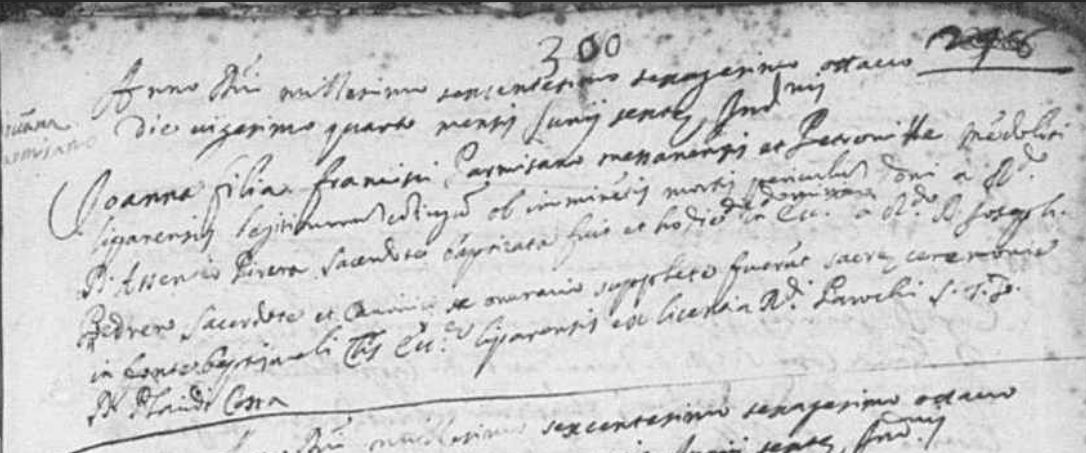
The first recorded Lipari baptism record for a Palmisano. Yes it is very difficult to read. |
The Palmisano family of Ustica is the largest clocking in at 1,240 descendants bearing the Palmisano surname as documented at the Ustica Genealogy Homepage at the time of this writing. The Palmisano were among the very first families to populate Ustica in the early 1760's. The first five years of church records from Ustica (1763-1767) show the presence of two distinct Palmisano Families.
Francesco Palmisano and Angela Benenati migrated to Ustica from Lipari with all of their children, some of whom had already been married and had children of their own back on Lipari. During those first five years of Ustica church records, four of their children marry and they are blessed with the births of six grandchildren. Their descendants make up 61% of all Palmisano descendants bearing the family surname.
Giuseppe Palmisano and Maria Giacino also appear to have migrated to Ustica with their mostly adult children, though it is unclear if he ever lived on Ustica. A 1765 Ustica marriage record indicates the bride, Maria Giacino, is the widow of Giuseppe Palmisano. A death record for Giuseppe Palmisano has not been found in either the Ustica or Lipari church records. Their son Pasquale Palmisano marries Rosa Ailara on Ustica in 1766 and they have a child the following year. The descendants of Pasquale Palmisano and Rosa Ailara represent 32% of all Palmisano descendants bearing the family surname.
The surname Palmisano has undergone some changes through time. That particular spelling doesn't become the standard until the 1820s in Ustica, though it does appear in the Lipari church registers as early as 1736. Throughout most of the documented history of the Palmisano family, the surname is spelled Parmisano, which can be interpreted as "a person from Parma". Perhaps some ancient ancestor pre-dating the documented history was from Parma, a city in the northern Italian region of Emilia-Romagna famous for its cheese. The letters l and r are also phonetically similar in their position in the surname, so this could just have been a case of a change in perferred spelling based on pronunciation. Maybe they changed it so it wouldn't be associated with the cheese. That would be funny. But, there is a much more interesting and telling history to the representation of the surname which we discover as we delve into the very earliest Lipari church records for the Palmisano family.
The Palmisano family came to Lipari rather late in the documented history of the Lipari church registers which starts in 1559. The first recorded baptism for a Palmisano child is in 1666 and in this time period there are two men named Francesco Palmisano having children concurrently. Turns out that our two distinct Palmisano families that first appear in Ustica retain that separation all the way back to the original two men named Francesco Palmisano.
The 1666 Lipari baptism record documents the birth of "Stefano figlio di Fra.co Parmarino di Calabria et Dominichella Costa di Lip.e" which translates as "Stefano son of Francesco Parmarino of Calabria and Domenica Costa of Lipari".

The first recorded Lipari baptism record for a Palmisano. Yes it is very difficult to read. |
The surname Parmarino, and variants of it, is used in the only other baptism record for this couple in 1669, and in both of the baptism records for children of their son Domenico and his wife Caterina Todaro in 1682 and 1684. It is in the third generation of this family in Lipari that the name Parmirano gives way to Parmisano. Only one baptism record of the thirteen documented for the children of Francesco and Angela Cristò uses the Parmarino form, with all others using Parmisano. Yes, that's right - thriteen documented births. Not untypical for the time if both parents could remain living for 20 years or more after marriage. That and a better than average mortality rate for their children are reasons that the Palmisano family grew so rapidly. One of our first brave Palmisano emigrants to Ustica, Giuseppe Palmisano, husband of Maria Giacino, is the son of Francesco Palmisano and Angela Cristò.
A 1668 Lipari baptism record documents the birth of "Joanna figlia Francisci Parmisano messananti et Petronille Me~doloti liparensis" which translates as "Giovanna daughter of Francesco Parmisano Messinite (a person from Messina) and Petronilla Mendoloti Liparense (a person from Lipari)".

A 1668 Lipari baptism using the variant Parmisano. This child wasn't expected to live "immine~tis mortis periculus" - imminent danger of death. |
The surname Parmisano is used consistently for baptism records of children of this couple and their descendants in Lipari. Our other brave Palmisano emigrant to Ustica, Francesco Palmisano, husband of Angela Benenati, is the grandson of Francesco Palmisano and Petronilla Mendoloti.
So, the records reveal two families whose surnames started out separate and distinct, Parmarino and Parmisano, but through time merged into one, Parmisano, which ultimately was supplanted by its current usage, Palmisano. Two families, one from Calabria and the other Messina - regions separated by the Straight of Messina at the northeastern tip of Sicily where it's nearest to the tip of the boot of Italy. We'll probably never know if these two families were related further back in time, but there is always hope for more research yet undiscovered and in the promising field of DNA study. So which Palmisano are you - or maybe you are both? Use the family charts at the Ustica Genealogy Homepage to discover your path back to the ancient origins of the Palmisano family of Ustica.